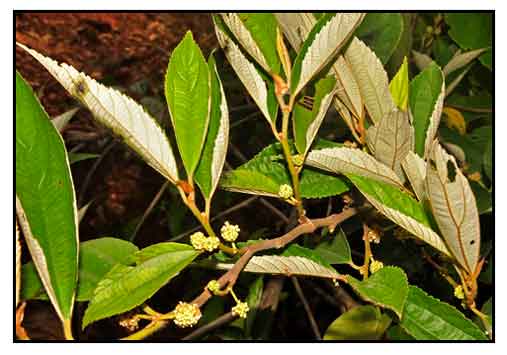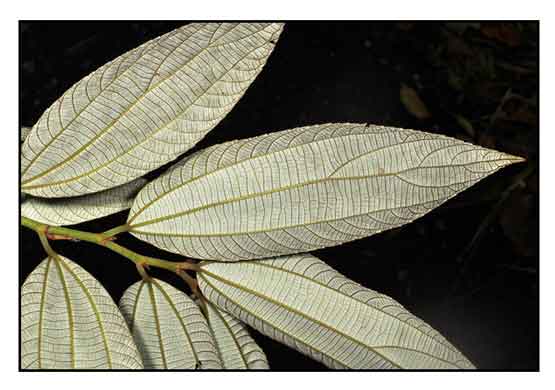 Botany Botany
Alagasi is an erect shrub
or small tree, reaching a height of 2 to 4 meters. Leaves are papery, oblong
or ovate, 10 to 15 centimeters long, 3 to 5 centimeters wide, felty and harsh to touch,
gray or chalky white beneath and green on the other side; pointed
at the apex, abruptly and broadly rounded, and 3-nerved at the base. Flowers
are capitate, on 8-millimeter long peduncles, either single or few-clustered, 1 centimeter in
diameter. Male flowers are white, upon short pedicels. Fruiting
heads are dark green, nearly spherical, with compressed achenes.
Distribution
- Native to the Philippines.
-
In thickets and
second-growth forests at low and medium altitudes throughout the Philippines.
- Also native to Bismark Archipelago, Borneo, Jawa, Lesser Sunda Is., Maluku, New Guinea, Solomon Is., Sulawesi, Sumatera, Vanuatu. (13)
 Constituents Constituents
• High Magnesium Content: The Kampung
(Leucosyke capitellata) leaves are particularly high in magnesium (626
mg/100 g). (1)
- Root extract yielded α-deoxysuagrs (Keller-Killary Test) and hydrolyzable tannins (Ferric Chloride Test). (see study below) (17)
Properties
- Studies have shown antioxidant, adaptogenic, antihyperglycemic,
antiplatelet, hepatoprotective properties.
Parts
used
Roots, leaves, sap.
Uses
Folkloric
- Decoction of roots and various concoctions of leaves, bark, and stems are used
for phthisis, coughs, headache and gastralgia.
- The Manobo tribe of Agusan del Sur, Philippines, used decoction of leaf for stomach aches and vomiting. (18)
- The Mamanwa tribe of Mindanao scrape the mature skin of stem to obtain the bark, and chew the bark for treatment of mouth ulcers (luas). (19)
- Subanens in Dumingag, Zamboanga del Sur, apply the bark on the throat for treatment of cough.
(7)
- Subanen tribe of Lapuyan, Zamboanga del Sur eat small amounts of stem for cough. Necklace made out of the outer layer of stem put around the child's neck for colds. Decoction made from trunk of L. capitellata with leaves of Coleus aromaticus and roots of Flemingia strobilifera drunk for cough. (16)
- Polyherbal decoction of a mixture of alagasi, Cordia dichotoma (Anonang), Ficus septica (Lagnob),
Dendrocnide meyeniana (Alingatong kahoy), and Sonneratia caseolaris (Pagatpat) drunk for relapse, fatigue, headache, body pains, fever and migraine. (20)
- In Malaysia, decoction
of leaves used for diabetes, high blood pressure and lumbago.
- In Kalimantan, Indonesia, plant used for treating stomach aches. (4)
- In Sabah, Malaysia, plant sap used as eye drops and for pain in the ears.
(3) Used by Kadazandusun tribe to treat diabetes. (2)
- In Borneo, decoction
of leaves used to treat hypertension and diabetes. (8)
Others
• Fiber: Bark used for its strong
bast fibers in making ropes.
• Scouring: Leaves, with its one-sided roughness, used for
scouring pots and pans.
• Wood: Durable, used for making implements, rice pounders, etc. Studies
• Antihyperglycemic / Antioxidant: Study evaluated L. capitellata leaves for its effect on blood glucose in streptozotocin-induced diabetic rats. Results suggest the leaves extract has the ability to reduce oxidative stress and possess antihyperglycemic effect in diabetic rats probably through its antioxidant property. (2)
• Adaptogenic / Anti-Stress / Roots: Study evaluated the adaptogenic effect of aqueous extracts of roots of Leucosyke capitellata on stress-induced mice based on time of exhaustion using the Swim endurance test. Extract yielded α-deoxysuagrs (Keller-Killary Test) and hydrolyzable tannins (Ferric Chloride Test). Mice pretreated with higher doses of alagasi roots exhibited longer duration of time compared to control. (9)
• Antioxidant / Anti-Stress / Roots: Study evaluated various extracts of leaves five plant species, the decoction, crude ethanol and 50:50 ethanol-water extracts of L. capitellata and L. aculeate showed antioxidant profiles comparable to those of standards ascorbic acid and butylated hydroxytoluene. (10)
• Antioxidant / Bark: Study evaluated the in vitro antioxidant activity of 37 methanolic extracts of Indonesian plants using DPPH assay. Twenty-nine of the samples exhibited radical scavenging activities of more than 50% at 1000 ppm. Five, including bark extracts of L. capitellata, exhibited high activities. (11)
• Hepatoprotective
/ CCl4-Induced Toxicity / Leaves: Study investigated the hepatoprotective effect of L. capitellata leaf decoction using carbon tetrachloride (CCL4)-induced hepatic damage in mice. The leaf decoction of leaf significantly decreased ALT, AST, and ALP (p<0.05) along with significantly increase TP level. Histopathological exam supported the biochemical improvements in liver damage. Reference drug was silymarin. (12)
• Antioxidant / Leaves: Study evaluated the antioxidant activities of decoction, crude ethanol and 50:50 ethanol:water extracts from leaves of five plant sources using DPPH and total phenolic contents. Best results were obtained from Leucosyke capitellata and Leea aculeata with comparable antioxidant profiles with reference standards ascorbic acid and BHT. (15)
• Antiplatelet Activity / Leaves: Study evaluated ethanolic extract of leaves of L. capitellata for antiplatelet activity. Results showed inhibition of blood coagulation. Plasma absorbance reduction before and after addition of ADP showed significant comparison from negative to positive control of 0.007 to 0.05. Previous studies have shown the presence of antioxidative flavonoid compound which may inhibit the adherence, aggregation and secretion of plates through its obstructive effect on the metabolism of arachidonic acid by cyclooxygenase. (17)
Availability
Wild-crafted. |


![]()

